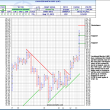by Patrick Rudden, AllianceBernstein
While fixed-income investors are growing increasingly aware of the risks of benchmark-oriented bond portfolios in a period of rising rates, equity investors have recently also started to question the wisdom of cap-weighted indices. We would go even further and argue that the performance of a cap-weighted benchmark may be irrelevant for the long-term goals of many institutional investors.
The problem is that such indices are, by construction, retrospective. In other words, they give the greatest weight to stocks that have done best (or in bond-land to the most indebted issuers). Buying the index, therefore, is a bet on the past; whereas good investing should be an exercise in forecasting the future drivers of economic success. Benchmarking can also have unintended consequences such as exposing a portfolio to heavy sector concentrations.
Benchmarking, of course, has its uses. It is helpful to look back and compare the performance of long-only stock pickers versus the universe of stocks they could have bought. A problem arises, however, when the benchmarking activity starts to influence the investing process. If managers know they are going to be measured against a particular benchmark, do they start to manage to that benchmark rather than just picking the most attractive stocks from the universe? The evidence is that they do, which we believe leads to suboptimal outcomes. So how can we break the negative behavioral feedback loop, which can cause the act of measuring the investment process to change the investment process itself in an undesirable way?
Defining Preferred Outcomes
We think investors should take a step back to clearly define their preferred outcomes and what they want to accomplish. For instance, an investor might have a liability-matching portfolio designed to accurately track forecast payments. In this case, the benchmark will be a portfolio of bonds and their derivatives that specifically matches the forecast cash flows. Because each investor’s liability profile is different, each will have a different benchmark.
On the growth side of the portfolio, an investor may seek to generate a return of 6%–7% and will look to hire managers who are capable of delivering those kinds of returns. This might be a long-only stock picker with a thoughtful process around balancing a forecast of economic success versus current valuations. But what happens if 10 years later the stock picker has delivered 7% annualized returns, while underperforming a widely available benchmark? How should the investor evaluate the original decision?
In hindsight, it would have been better to invest in the benchmark, but without a time-machine that observation is of academic interest only. Instead, if the stock picker stuck to a well thought through and disciplined process that successfully delivered the target growth, the investor should be satisfied, as unnatural as this might sound. In an ever-faster world of instant reporting and measurements, does it really make sense to monitor and judge long-term goals by the day or minute? It would be better for investors to focus on the specific outcomes they need to accomplish and then to measure progress first and foremost against those targets.
More Diversification With Increased Tracking Error
Benchmarks may make sense when they are tailored to an individual investors needs and desired outcomes. But measuring performance against backward-looking benchmarks is probably not a good way for investors to meet their long-term goals.
Relative return and tracking error probably do not align with many investors’ long-term needs—which are in absolute terms. And freeing a portfolio from the benchmark leads to increased tracking error that can give a manager much more leeway to build a portfolio with broader diversification of aggregate exposures.
The views expressed herein do not constitute research, investment advice or trade recommendations and do not necessarily represent the views of all AllianceBernstein portfolio-management teams.
Patrick Rudden is Portfolio Manager, Dynamic Diversified Portfolio at AllianceBernstein.
Copyright © AllianceBernstein















